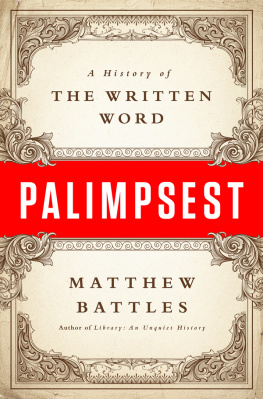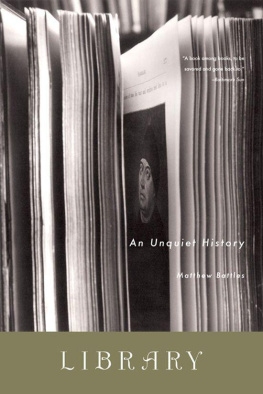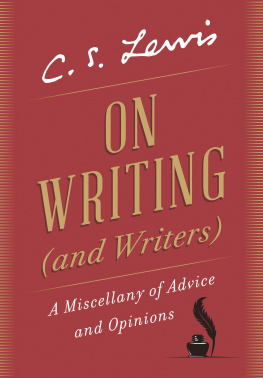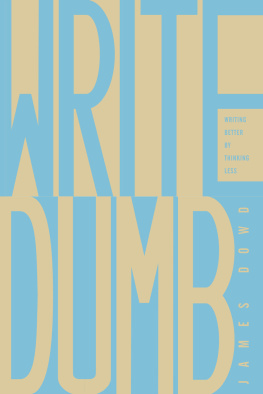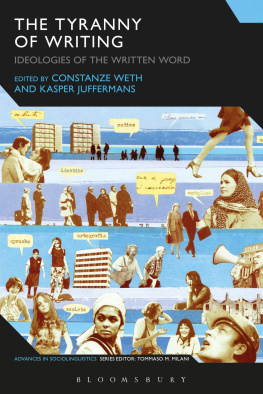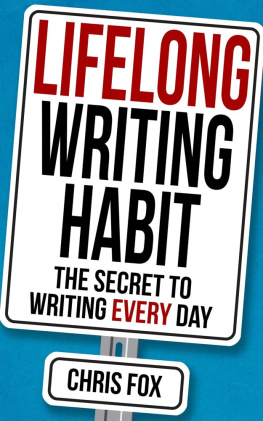
ALSO BY MATTHEW BATTLES
Library: An Unquiet History
Widener: Biography of a Library
The Sovereignties of Invention
The Library Beyond the Book
(with Jeffrey Schnapp)

Copyright 2015, by Matthew Battles
All rights reserved
First Edition
For information about permission to reproduce selections from this book, write to Permissions, W. W. Norton & Company, Inc.,
500 Fifth Avenue, New York, NY 10110
For information about special discounts for bulk purchases, please contact W. W. Norton Special Sales at specialsales@wwnorton.com or 800-233-4830
Book design by Love Dog Studio
Production manager: Louise Mattarelliano
ISBN 978-0-393-05885-7
ISBN 978-0-393-08951-6 (e-book)
W. W. Norton & Company, Inc., 500 Fifth Avenue, New York, NY 10110
www.wwnorton.com
W. W. Norton & Company Ltd., Castle House, 75/76 Wells Street, London W1T 3QT
CONTENTS
PALIMPSEST
I am left-handed, and my first-grade teacher didnt know what to do with me. The Palmer Method handwriting books, which many will recall in a haze of nostalgia and revulsion, were authored in a right-handed world, where paper was always tilted counterclockwise and pencils were never pushed, but only pulled. We should understand these methods as the introduction of ethics into the body, a set of orthodoxies to be performed, ablution-like, over the production of sacred text. Only my body, however subtly, was arranged according to a different order and would not respond to Miss Ws ethical demands: Keep your back straight, adjust the paper to the proper angle, hold the pencil with gentle pressurenormative injunctions with the force of the Decalogue or the Golden Rule. Despite the admonishmentsand despite the multicolored variety of rubber appliances and prostheses affixed to my pencilsI persisted in hooking my wrist, turning the paper the wrong way, and giving my apprentice characters a reprobate slouch and a blurry smudge. Where it had slid across the paper, the meat of my left hand glowed with the dull shine of graphite.
I soldiered on, howeverfor even before I could read or write, the letters of the alphabet had achieved fixed and peculiar characters known only to me: the letter M , for instance, was clearly browna low-nosed, snuffling, square-bodied beast. H was a house, alliteratively enough, black and strong, with room enough for all the other letters if it rained. As for A , which was white as distance itself, it was clearly a pair of railroad tracks recedingor sometimes, the house of H seen from below, looming in enormity, its topmost ramparts converging in the sky. And so on. For such reasonsfor the glamor of the lettersI persevered, despite Miss Ws impatience.
As I grew older, the graphic synesthesia faded. My devotion to letters only grew, however; and when I was about eleven, I took up calligraphy. I borrowed library books describing chancery italic, blackletter, and something breezy and chilled called Gaelic round handeach character dismembered on the page, its strokes anatomized, numbered, named. My parents indulged me with trips to the art-supply store for the necessaries: penholders; fat, promising bottles of inks in all colors; and the faintly menacing steel nibswhich, I was gratified to discover, came in left-handed models, with points specially angled. It all came to an end when I botched another teachers wedding announcementmy first commission, and my last.
My dads typewriter offered other pleasures. It was an undistinguished Royal, and a portable, which lived in a plastic briefcase all its own. I liked to hammer away at the keys while it sat before me, nestled like some kind of chattering clam in its open case, and fill numberless pages with its loose-limbed, monospace characters. In truth, I found the sharp letter arms swinging in their oblique angles faintly menacing, an unwitting evocation of William S. Burroughss monstrous, arthropodal Clark Novathough when I pushed all the keys I could cover with my two open palms, they crowded rather ridiculously at the platen, less a locusts maw than a mob of rowdy fans lining up at a ticket window. As with calligraphy, I was more interested in making marks than making sense; at the typewriter, I busied myself creating meaningless grids of letters, letters in waves and curves, big letters pieced together out of small.
A few years later, a friend received an electronic typewriter for a birthday. It was a Smith-Corona with a tiny, wet-looking rectangle of liquid crystal topping the keys; in auto mode, one typed without making marks on paper, watching instead as a parade of alphanumerics piled by in pixelated lockstep. Saved to a memory buried somewhere in the machines innards, the characters would later tumble and smash their way onto pages of letter-size bond at the touch of a button. A group of us clustered around it when the time for senior-year theses arrived, watching in rapt silence as the thing typed out a fifteen-page term paper with unearthly speed, keys untouched as the daisy wheel rattled and spun.
Already by junior high, however, there had been rumors of computers; one midwinter quarter, a clutch of beige Apple IIs took up residence in a disused shop classroom. Their displays filled up with letters in unearthly green, stacked clumsily out of tiny blocks of glow. But these were letters that could do things, make things; they seemed to pick and choose their forces and effects in ways unknown to the letter on the page. They seemed less symbols or servants than companions crowding into the space of the screen, claiming a life of their own from electricity and the black-boxed quiddity of the system.
I summon up this grab bag of biographical oddities to explain why Ive turned to a history of writing, and to intuit what hope might be recoverable from that history for writings fate in the digital age. In my reading for this book, Ive looked for glimmers of the same fascination with letters, with script, and with the material of writing that has been a fixture of my imagination from the start. But these glimmers shine beyond the limits of personal obsession: calligraphy, the Palmer Method, the portable typewriter, the Apple II: each indexes a shift in writing as a mode of personal experience. But they are not so much inevitable stages of a teleology as they are moments in the long, churning life of the written word.
In the writing we doin the writing I do anyway, day in and day outthese modes and materials lie superimposed, one atop the other, mingling and a-jumble. My finger still remembers the ridged callus raised by pencils too-tightly held; the tap-a-tap chant of the typewriter sings subconsciously as I caress the keys of my MacBook Air. These textures of sense and method come together like a palimpsestan ancient form of recycling, which the Oxford English Dictionary defines as a writing surface on which the original text has been effaced or partially erased, and then overwritten by another. This practical paean to ancient economy doesnt exhaust the meanings of palimpsest, however; for as the OED points out, the word also refers, in extended use, to a thing likened to such a writing surface, esp. in having been reused or altered while still retaining traces of its earlier form. The OED marshals the words of Thomas De Quincey in support of this definition: What else than a natural and mighty palimpsest is the human brain?
A Letter is a joy of Earth
It is denied the Gods
EMILY DICKINSON
See, I have engraved you on the palms of my hands;
Next page
